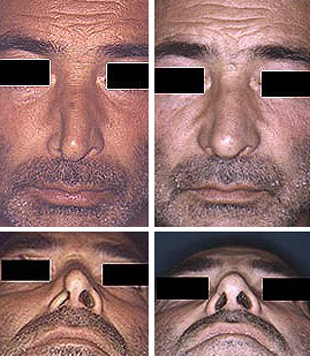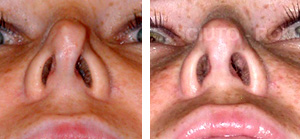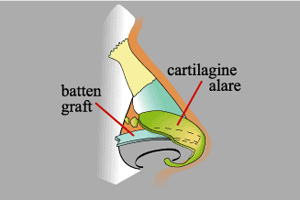

Sometimes the nostril is so weak it is sucked inwards
with the passage of air, thus preventing effective respiration.
Right: after reconstructive surgery of the support structures
of the tip of the nose.

Incompetence of the external nasal valve in a patient
already operated on for rhinoplasty with serious breathing
difficulty particularly at night. Right: after the correction.

Batten graft technique for the correction of the alar cartilages.
When I breathe my nostrils are closed
The nostrils i.e. the external openings of the nose are kept open by two cartilage structures, one right and one left, called alar cartilages. Sometimes these cartilages are so weak that they cannot maintain the nostrils enlarged and so tend to close, especially during inspiration (when air enters the nose). This weakening is called "insufficiency or collapse of the external nasal valve".
As in the case of "insufficiency of the inner nasal valve" this phenomenon is accentuated during forced inspiration (when you try to breathe in fast and/or deeply like during a race or physical exertion).
What causes insufficiency of the external nasal valve?
This situation essentially occurs in the following cases:
- When the alar cartilages are particularly thin or weak congenitally.
- When the alar cartilages have a distorted shape or are folded towards the inside of the nostrils
- When the alar cartilages are weakened or damaged from a previous surgery or an accident.
Many people, who suffer from these problems, including some athletes, use external nasal dilation devices that are particularly effective in these cases. Others stretch the skin of the cheeks outward with their hands enlarging the nostrils a little in order to breathe more easily. Some have already been operated on the nasal septum but have not resolved their problem since the cause of badly breathing is not deviation of the septum, but rather a nasal valve incompetence.
What can be done?
When there is confirmation that the cause of poor respiration is the inadequate functionality of the external nasal valve surgical correction can be attempted. The surgery aims to return the alar cartilages and the tip of the nose to their correct shape. It is almost always necessary to use cartilage grafts from the patient in order to reconstruct the arc of the alar cartilages and give back shape and structure to the tip.
One particular type of graft that is very effective in this instance is the so-called "batten graft" that was popularized by the American surgeon of Japanese origin Dr. Dean Toriumi.
This technique, shown in the diagram, is used today by the most expert ENT surgeons and can serve, when indicated, to restore the correct shape and the correct rigidity to the alar cartilages.
Rhinomanometry, rhinometry and nasal endoscopy are the tests necessary to study these irregularities and to evaluate surgical possibilities.